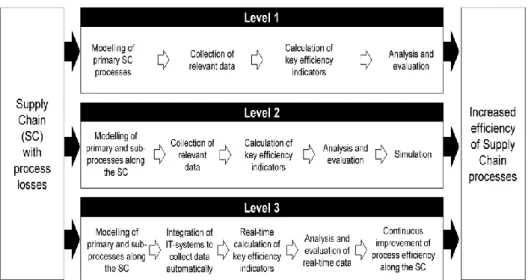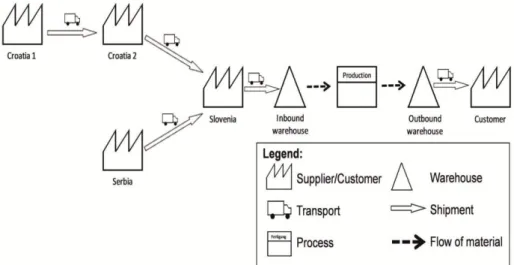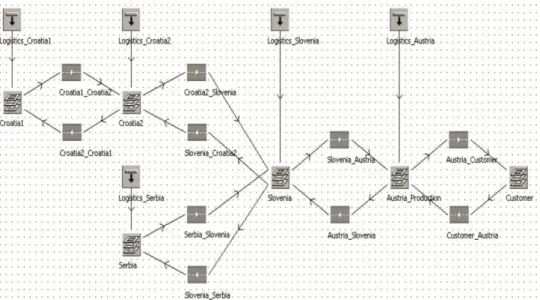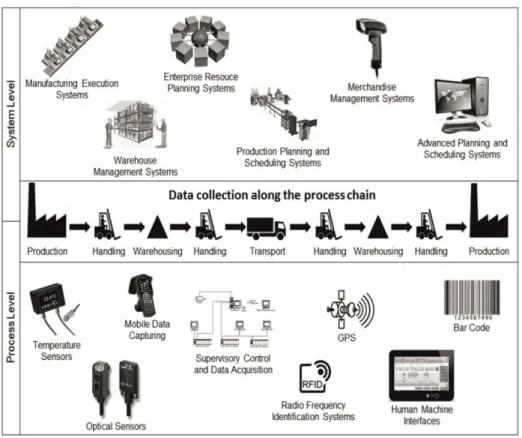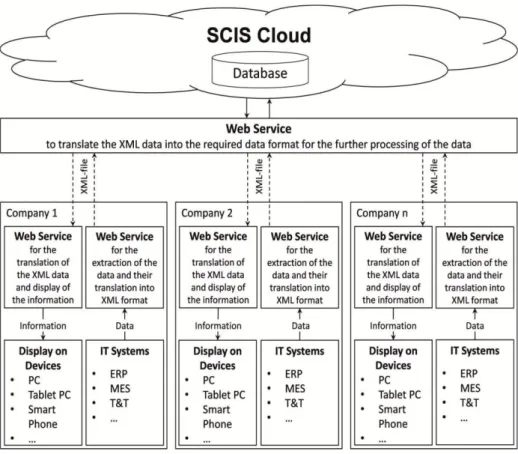CONCEPTUAL CONSIDERATIONS FOR REAL-TIME
SUPPLY CHAIN EFFICIENCY MONITORING
Herwig Winkler*
* Department Production/Operations Management, Brandenburg University of Technology Cottbus-Senftenberg, Siemens-Halske-Ring 6, 03046 Cottbus, Germany,
Email: winkler@b-tu.de
Abstract. A recent simulation study proved that the efficiency of supply chains is highly volatile because of a number of different factors. Therefore, we elaborated a model to evaluate supply chain efficiency. In our contribution, we will show the results of a case study and present considerations for real-time efficiency monitoring.
Paper type: Research Paper Published online: 28 October 2016 Vol. 6, No. 5, pp. 393–405
DOI: 10.21008/j.2083-4950.2016.6.5.2 ISSN 2083-4942 (Print)
ISSN 2083-4950 (Online)
© 2016 Poznan University of Technology. All rights reserved.
1. INTRODUCTION
Strictly speaking, the term “logistics” describes either the movement of goods and items or the flow of information. Thus, logistics involves the spatial movement of goods, items, or information over time. More precisely, logistics is an integrated system of interdependent primary and subordinate processes that bridge internal and cross-company interfaces. Thus, logistics supports entrepreneurial actions and services, such as production processes, in which input factors are transformed into a specified output. However, logistics itself also requires a certain input factors to generate output in terms of logistics services.
With this in mind, the overall objective of logistics is high efficiency. Logistics efficiency is indicated by the ratio between logistics costs that are dependent on the deployed resources and logistics performance that represents the logistics service level. Thus, efficiency indicators combine cost and performance targets. High lo-gistics efficiency results from an optimum input-output ratio of the lolo-gistics proc-esses, which is maintained over a certain time if the deployed logistics resources are successively reduced while the logistics service level is gradually increased.
Logistics performance is indicated by the availability of goods and materials, lead time, delivery time, reliability, and flexibility. Logistics performance, how-ever, does not occur coincidentally, but is the result of forecasts and planned logis-tics targets with respect to costs, quantity, quality, and time. These targets deter-mine the rating of logistics efficiency indicators. Thus, logistics efficiency repre-sents the degree of short-term target achievement in logistics. Presently, due to globally competing supply chains, the simultaneous achievement of several logis-tics targets is required to obtain high logislogis-tics efficiency. Reduced efficiency is often due to various process losses (Winkler, 2011); sometimes, an alternative process might be superior to the existing process to reach the planned logistics targets. The extent of the efficiency reduction depends on the variance between the planned and actual values of the examined logistics process. When logistics effi-ciency is reduced because of failures or misconduct, the necessary process adjust-ments must be planned and implemented.
Heretofore, logistics efficiency has been analyzed predominantly within a single company. Lean Management, Business Process Re-engineering, and Benchmarking are examples of managerial approaches used to identify and purposefully mitigate or avoid operational inefficiencies (Stewart, 1995). The result is an improved in-put-output ratio of logistics processes per unit of time. In entrepreneurial practice, it has become increasingly important to expand the internal efforts of efficiency improvement to an intercompany level. These endeavors are well known as Supply Chain Management. In this concept, the objective is coordinated planning, manag-ing, and control of logistics processes from suppliers to producers and retailers along the entire supply chain to achieve an efficient flow of goods and information (Winkler & Kaluza, 2006). Traditional improvement projects that aim to increase
the efficiency of logistics processes along the supply chain, however, are doomed to failure because no appropriate evaluation of the improvement potential exists. This deficit must be resolved by using sophisticated and comprehensive metrics as well as system dynamics models that facilitate the identification and elimination of the sources of process loss.
This paper presents a practical approach to improving logistics efficiency along the entire supply chain. In this context, logistics is perceived as the accumulation of many primary and subordinate processes associated with various business func-tions (Engblom et al., 2012). Each logistics-related activity or service is the result of a combination of such specific processes. Therefore, we briefly clarify the con-cept of efficiency in logistics processes. Then, the current gaps in the efficiency evaluation of logistics processes along the supply chain will be described. This is followed by a detailed introduction to the developed Supply Chain Improvement System (SCIS), in which the requirements identified by the representatives of in-dustrial enterprises during the course of an empirical study and the consequent functionalities of the SCIS are presented. Finally, the elaborated efficiency im-provement system at the supply chain level is described in detail.
2. BASICS OF A SUPPLY CHAIN IMPROVEMENT SYSTEM (SCIS)
2.1. Structure of a SCIS
The main difference between traditional process improvement at the enterprise level and intercompany efficiency improvement with the help of the SCIS is the method and extent of the efficiency evaluation. For intercompany efficiency improvement, it is necessary to evaluate the efficiency of all of the logistics processes along the entire supply chain. Thus, the major task is efficiency evaluation of the different primary and subordinate processes in the fields of production logistics, transport, handling, and warehousing; i.e., from the raw-material supplier to the end customer. For reasons of overview and interpretation, it is recommended that appropriate efficiency indicators are developed to represent the results of the initial process evaluation. Additionally, calculating value-added time with respect to its share of the total lead time increases the informative value of the elaborated efficiency indicators. However, the calculation of efficiency indicators requires specific tools and methods for data collection and processing. The SCIS offers a wide range of functionalities that serve this purpose.
The conceptual structure of the SCIS in Figure 1 is characterized by an architecture with three different application levels, which can be applied indepen-dently. Level 1 is the simplest way to conduct a supply chain improvement project. After the primary supply chain processes – transport, handling, warehousing, and
production – are modeled, it is necessary to collect the relevant process data for the supply chain analysis. Consequently, the relevant efficiency indicators must be calculated in the described manner, and the calculation results must be analyzed. Applying level 2 of the SCIS requires a much more detailed model of the relevant supply chain. This model is developed using simulation software. The simulation model of the relevant supply chain is provided with the required process data to calculate the efficiency indicators. The specific advantage of level 2 is the oppor-tunity to conduct simulation studies. In contrast to levels 1 and 2, level 3 of the SCIS must not be regarded as a project. It is much more along the lines of a true IT system that supports decision makers in improving supply chain efficiency. Therefore, a detailed model of the supply chain must be developed, and all relevant IT systems that produce and collect required process data in real time must be integrated (Winkler et al., 2013).
Fig. 1. The three levels of the SCIS
2.2. Using metrics for supply chain efficiency evaluation
For the SCIS, the adaptation of internal efficiency metrics or indicators to the supply chain level is important. Depending on the individual requirements, key indicators are available in the scientific literature, as well as in entrepreneurial practice, for the evaluation of the efficiency of logistics processes. The traditional concept of Overall Equipment Efficiency (OEE) is considered to be one of these key indicators and is an example of how to evaluate the efficiency of production. The OEE calculation includes the operational availability, as well as the level of performance and quality (Muchiri and Pintelon 2008; Braglia et al. 2009). The efficiency evaluation of transport processes is conducted similarly. However, we
recommend two ways to proceed: (1) The evaluation of Productive Vehicle Utilization, which represents capacity utilization and (2) the evaluation of Overall Tran-sport Efficiency, which considers the operation of the means of transport. The Productive Vehicle Utilization is determined by the maximum freight hold volume, which is compared to the current use of capacity. The operating efficiency of a means of transport, in turn, is determined by the transport time with special regard to the respective transport conditions. Additionally, the total time that a means of transport is available for value-added processes is compared to its actual operating time (Delivand et al., 2011). The efficiency of the handling processes is also represented by two specific efficiency indicators, i.e., Handling Efficiency and Handling Equipment Efficiency. The basis for calculating Handling Efficiency is the total working time of the employees that are available for the handling processes. Subsequently, this value is reduced by any time losses that occur. Conversely, Handling Equipment Efficiency indicates any losses that are generated by deployed handling equipment. For storage efficiency, three indicators that consider different processes are used to guarantee the objective evaluation of storage processes. Inventories, warehouse operations, and the amount of storage space influence the efficiency evaluation of warehousing processes. The indicator, Productive Warehousing, provides information on the efficiency of the warehouse processes because the total time that is available for warehousing is reduced by various process losses. The Productive Stock, in turn, is the ratio between the actual stock at hand and stock that is economically purposeful. Thus, this calculation indicates overstocking. Productive Storage Utilization represents the ratio between the actual capacity utilization and the storage capacity that is economically purposeful, which indicates the excess storage space. In addition to the previously described efficiency indicators, the calculation of Average Supply Chain Efficiency serves to provide information about the input-output ratio of the entire supply chain. For this purpose, the value-added time along the supply chain is accumulated and compared to the potential productive time along the supply chain. Here, the potential productive time is determined by summing the value-added and non-value-value-added times along the examined supply chain.
3. A BRIEF CASE STUDY FOR DEMONSTRATING TYPICAL
EFFICIENCY LOSSES IN SUPPLY CHAIN
The investigated company in this case operates in two different countries on three production sites. For the case study, we have collaborated with one of these production sites. During the implementation of the SCIS on level 2 to validate the practical applicability of the concept, the project launch was determined by select-ing a manageable supply chain area. Therefore, the supply chain area for a specific product of the cooperating company’s product portfolio was defined. The product
consists of four components, but to reduce complexity for the purposes of the pro-ject, only the shipment of two of them will be considered. The first component is sequentially manufactured on two different production sites in Croatia. Meanwhile, the second component is produced in Serbia. Both components are shipped to a handling terminal in Slovenia, where they are commissioned and transported together by truck to the manufacturer in Austria. In Austria, the components are assembled into the final product. Subsequently, the product is transported by truck to the customers, who are primarily located in Germany. The executed supply chain improvement project, with the application of the SCIS on level 2, addresses the transport processes between the following entities: the two suppliers in Croatia, between Croatia and both Serbia and Slovenia, between Slovenia and Austria, and between Austria and the customers in Germany. In addition to the transport processes, the production processes of the Austrian manufacturer, as well as the handling processes are part of the project. Moreover, the warehouses for the manu-facturer’s inbound and outbound shipments are considered. Figure 2 shows the selected supply chain area.
Fig. 2. The supply chain area analyzed applying the SCIS on level 2
Following the development of the simulation model, the efficiency indicators Subsequent to the selection of the relevant supply chain area, a detailed simulation model was developed. In accordance with the top-down principle, the authors started by modeling the supply chain area with its primary elements. The model was refined by developing several sub-models for specific supply chain entities or processes. The final model contains all of the mentioned and described entities of the supply chain area including all of the relevant primary supply chain processes.
The simulation model was developed with the support of specific simulation soft-ware. Figure 3 shows the elaborated simulation model on the supply chain level.
Fig. 3. The simulation model of the selected supply chain area
For the objective evaluation of the primary supply chain processes and the en-tire supply chain were implemented. For this purpose, it was necessary to connect data from the real supply chain with the integrated formulas in the simulation model. Based on that data, the required indicators were computable by using the simulation tool. After the indicators were implemented, a simulation run was started to show the development of the efficiency indicators over a period of thirty days. This chapter will not focus on the results of each efficiency indicator, but the results of the SCE will be explained (Kuss & Winkler, 2014). However, after simu-lating the supply chain processes over thirty days, the average SCE was evaluated at 3.78 percent, which seemed to be very low. Thus, the indicator was analyzed in detail by revising the development of the SCE over the thirty days simulation pe-riod, which is presented graphically in Figure 4.
4. DEVELOPING A REAL TIME SUPPLY CHAIN EFFICIENCY
MONITORING
The level 3 of the SCIS enables continuous efficiency improvement with the support of various IT systems. Therefore, a detailed model of the relevant supply chain is a prerequisite. This model must be developed in a specific SCIS IT system that further integrates all other relevant IT systems along the selected supply chain area. Examples of such IT systems are enterprise resource planning, manufacturing execution, transport data, and radio frequency identification systems. These sys-tems provide most of the data required to calculate the efficiency indicators in real time. The real-time calculation results are displayed by a management cockpit and can be analyzed by decision makers, who are thereby able to elaborate specific measures to improve the efficiency of the investigated supply chain. To integrate all relevant companies along a supply chain, including integrating their IT land-scapes, the SCIS operates as a cloud solution. Thus, all companies that are part of a supply chain are connected with one another via the SCIS cloud, which collects relevant process data from these companies and processes the data using a vast data base and an adequate data base management system. The task of the database man-agement system is to process the captured data into the required efficiency indica-tors. Additionally, the calculated indicators are displayed by the SCIS management cockpit. Specific decision makers, such as supply chain managers, are provided with the graphical representation of the efficiency indicators in real time. Thus, the measures necessary to increase process efficiency can be planned and realized promptly.
Now, to correctly implement level 3 of the SCIS and to calculate the relevant efficiency indicators, technologies are required for data acquisition, processing, and storage. Within the four primary supply chain process categories – transport, han-dling, warehousing, and production – various technologies and systems are
re-quired to capture all necessary data to calculate the relevant indicators. At the sys-tem level, production data are provided by manufacturing execution, production planning and scheduling, enterprise resource planning, and advanced planning and scheduling systems (Winkler et al., 2013).
Fig. 5. Systems and technologies to collect relevant process data along a supply chain
Additionally, IT systems provide relevant warehouse data including, warehouse management, merchandise management, and enterprise resource planning systems. The mentioned systems typically also provide most of the required data for evaluat-ing the efficiency of the handlevaluat-ing and transport processes. To acquire data that are not provided by the mentioned IT systems, it is necessary to apply specific data acquisition technologies at the process level. Depending on the supply chain pro-cess category, such technologies include, e.g., radio frequency identification, the global positioning system, various sensors (temperature, optical, etc.), bar code systems, mobile data-capturing concepts, human machine interfaces, and supervi-sory control and data acquisition technologies (Cutting-Decelle et al., 2012). How-ever, to implement level 3 of the SCIS, it is necessary to integrate all of the required data acquisition technologies and systems from all partners along the
rele-vant supply chain area. Figure 5 shows the systematic connection between systems and technologies for collecting the relevant data to calculate the efficiency indica-tors within the four primary supply chain process categories along supply chains.
Integrating all of the abovementioned IT systems and applying specific data acquisition technologies, the SCIS acts in the form of a cloud. Moreover, the inter-net-based SCIS cloud contains a database and specific business intelligence con-cepts. However, the comprehensive integration of the SCIS on level 3 also requires specific technologies and concepts for standardized data exchange and data trans-fer. Some of the most relevant technologies for developing the SCIS concept on level 3 and their roles in supply chain improvement efforts are described below.
The data transfer challenge for the SCIS is the variety of IT systems along sup-ply chains. Typically, a supsup-ply chain is constituted by a specific number of compa-nies from various industry sectors that apply data management software according to their specific needs; generally, each company has individual IT solutions (Nurmilaakso, 2008). Because of the large variety of companies with different IT landscapes, there is a need for standardized technology to transfer relevant data to the SCIS cloud. Web services, extensible markup language (XML), and electronic data interchange (EDI) are technologies and concepts that support standardized data exchange (Nurmilaakso, 2008).
Considering the concept of the SCIS on level 3, the application of web services is an appropriate way to manage the challenge of different IT systems that have to be integrated within the SCIS. Web services are software systems that enable data exchange or that call up the activities of remote systems; thus, the use of web ser-vices allows for connecting programs across distant points worldwide via the inter-net (Daigneau, 2012). Various interinter-net-based applications can be connected by web services, enabling program-to-program communication. Using web services, vari-ous applications at different locations can be integrated into one large IT system. Moreover, applying web services provides the required measures for integrating different systems (Daigneau, 2012). It is the task of SCIS-related web services to collect relevant data from the different IT systems of all relevant supply chain part-ners and to transform them into a consistent and standardized data format.
The application of web services requires the use of different technologies based on XML to enable data transformation and transmission out of and into various programs and databases. Using XML, web services can be mapped to applications including programs, objects, and databases or to any comprehensive business func-tion (Newcomer, 2002). For example, the web service descripfunc-tion language (WSDL) that is used to describe web services, including their functionality, is based on XML as well; for example, WSDL uses XML grammar to specify a pub-lic interface including all data information for all XML messages (Cerami, 2002; Daigneau, 2012).
Furthermore, XML is the standard used for data transfer between companies along the relevant supply chain and the SCIS. Web services collect the required data from the supply chain partners’ IT systems and transform them into XML files
that are transmitted to the SCIS cloud. However, before the data are transmitted to the SCIS database, a web service transfers the information into the required data format for calculating an efficiency indicator. Subsequently, the calculation results are transferred to the companies and managers along the supply chain and vice versa, again using web services and XML technology. Figure 6 shows the operat-ing mode of the SCIS on level 3 regardoperat-ing the use of specific data transfer techno-logies.
Fig. 6. The operation mode of the SCIS on level three regarding data transfer
Although the theoretical concept development of level 3 of the SCIS has already been advanced, no case study has been conducted yet because implementing the SCIS at the third level is quite complex and extensive. Additionally, the elaborated theoretical concept must be extended by a comprehensive technological concept. Therefore, the support of an IT service provider is required to implement the SCIS on level 3 in entrepreneurial practice. The main challenge for the IT company will be integrating all companies along a supply chain and managing the resulting inter-faces between these companies and the SCIS cloud.
However, the authors intend to proceed with developing the SCIS on level 3, and a level 3 efficiency improvement project in entrepreneurial practice is planned for execution in the coming years.
5. CONCLUSION AND FUTURE RESEARCH DIRECTIONS
In the context of Supply Chain Management, an increasing integration of the entire process chain and its goal-oriented design and improvement are currently challenging entrepreneurial practice; thus, it is a major area of research for the sci-entific community. In this paper, we have shown that objective evaluation is re-quired to efficiently design and purposefully improve logistics processes along the supply chain.Future research work considering the SCIS concept will focus on the further de-velopment of level 3. In addition to working out the concept’s technological oper-ating mode, it will be necessary to improve the usability of the system itself. Thus, various alternatives to provide decision makers along the supply chain with rele-vant efficiency data will be developed and tested. Furthermore, a case study to show the practical applicability of the SCIS on level 3 will be performed. There-fore, it will be necessary to collaborate with an IT service provider who is able to develop and manage the resulting interfaces between the SCIS and the companies along the supply chain. In addition to managing IT interfaces along the supply chain and addressing the required data acquisition and data transfer technologies, one key aspect of further research in this context will be the graphical representa-tion of the efficiency data generated by the SCIS. Thus, it will be necessary to de-velop a user interface that provides decision makers with the required information from anywhere along the supply chain in the form of actionable knowledge any-where and anytime.
Moreover, future research activities to improve the SCIS concept include con-ducting simulation studies to define the appropriate measures for sustainably im-proving supply chain efficiency. Toward this end, an adaptive assistance system based on simulations will be elaborated.
An additional future task will be to extend the original SCIS approach by pro-viding financial data. The financial information will support managers and other employees with entrepreneurial responsibility in making well-founded decisions to improve the entire supply chain or selected supply chain areas.
REFERENCES
Braglia M., Frosolini M. & Zammori F. (2009), Overall equipment effectiveness of a manu-facturing line (OEEML), An integrated approach to assess systems performance. Journal of Manufacturing Technology Management, Vol. 20(1), pp. 8–29.
Cerami E. (2002), Web Services Essentials, O’Reilly, Sebastopol.
Cutting-Decelle A.F., Barraud J.L., Veenendaal B. & Young R.I. (2012), Production infor-mation interoperability over the Internet, A standardised data acquisition tool developed for industrial enterprises, Computers in Industry Vol. 63(8), pp. 824–834. Daigneau R. (2012), Service Design Patterns – Fundamental Design Solutions for
SOAP/WSDL and RESTful Web Services, Pearson, Upper Saddle River.
Delivand M., Barz M. & Gheewala S. (2011), Logistics cost analysis of rice straw for bio-mass power generation in Thailand, Energy, Vol. 36(3), pp. 1435–1441.
Engblom J., Solakivi T., Töyli J. & Ojala L. (2012), Multiple-method analysis of logistics costs, International Journal of Production Economics, Vol. 137(1), pp. 29–35. Kuss C. & Winkler H. (2014), Using simulations to improve logistics efficiency along
sup-ply chains. Proceedings of The 11th International Conference on Logistics & Sus-tainable Transport, Celje.
Muchiri P. & Pintelon L. (2008), Performance measurement using overall equipment effec-tiveness (OEE): literature review and practical application discussion, International Journal of Operations & Production Management, Vol. 46(13), pp. 3517–3535. Newcomer E. (2002), Understanding Web Services, Pearson, Boston, MA.
Nurmilaakso J.M. (2008), Adoption of e-business functions and migration from EDI-based to XML-based e-business frameworks in supply chain integration, International Journal of Production Economics, Vol. 113(2), pp. 721–733.
Stewart G. (1995), Supply chain performance benchmarking study reveals keys to supply chain excellence, Logistics Information Management, Vol. 8(2), pp. 38–44.
Winkler H. (2011), Closed-loop production systems – A sustainable supply chain approach, CIRP Journal of Manufacturing Science and Technology, Vol. 4(3), pp. 243–246. Winkler H. & Kaluza B. (2006), Integrated Performance and Risk Management in Supply
Chains – Basics and Methods. In: W. Kersten & T. Blecker (eds.), Managing Risks in Supply Chains – How to Build Reliable Collaboration in Logistics, Berlin, pp. 19–36. Winkler H., Wurzer Th., Kuss C. & Seebacher G. (2013), Improving Logistics Efficiency
in Supply Chains using a Supply Chain Improvement System (SCIS). Proceedings of The 10th International Conference on Logistics & Sustainable Transport, Celje.
BIOGRAPHICAL NOTES
Herwig Winkler is a full professor and holds the chair of Production Management at
the Brandenburg University of Technology Cottbus-Senftenberg. He is the author and co-author of various articles addressing current topics in selected areas of production management like flexibility research, technology management, mass customization, supply chain management, and green logistics. His research was published in renowned peer-reviewed international journals and presented at international conferences. For more information please visit <https://www.b-tu.de/fg-produktionswirtschaft/team/professor>.
